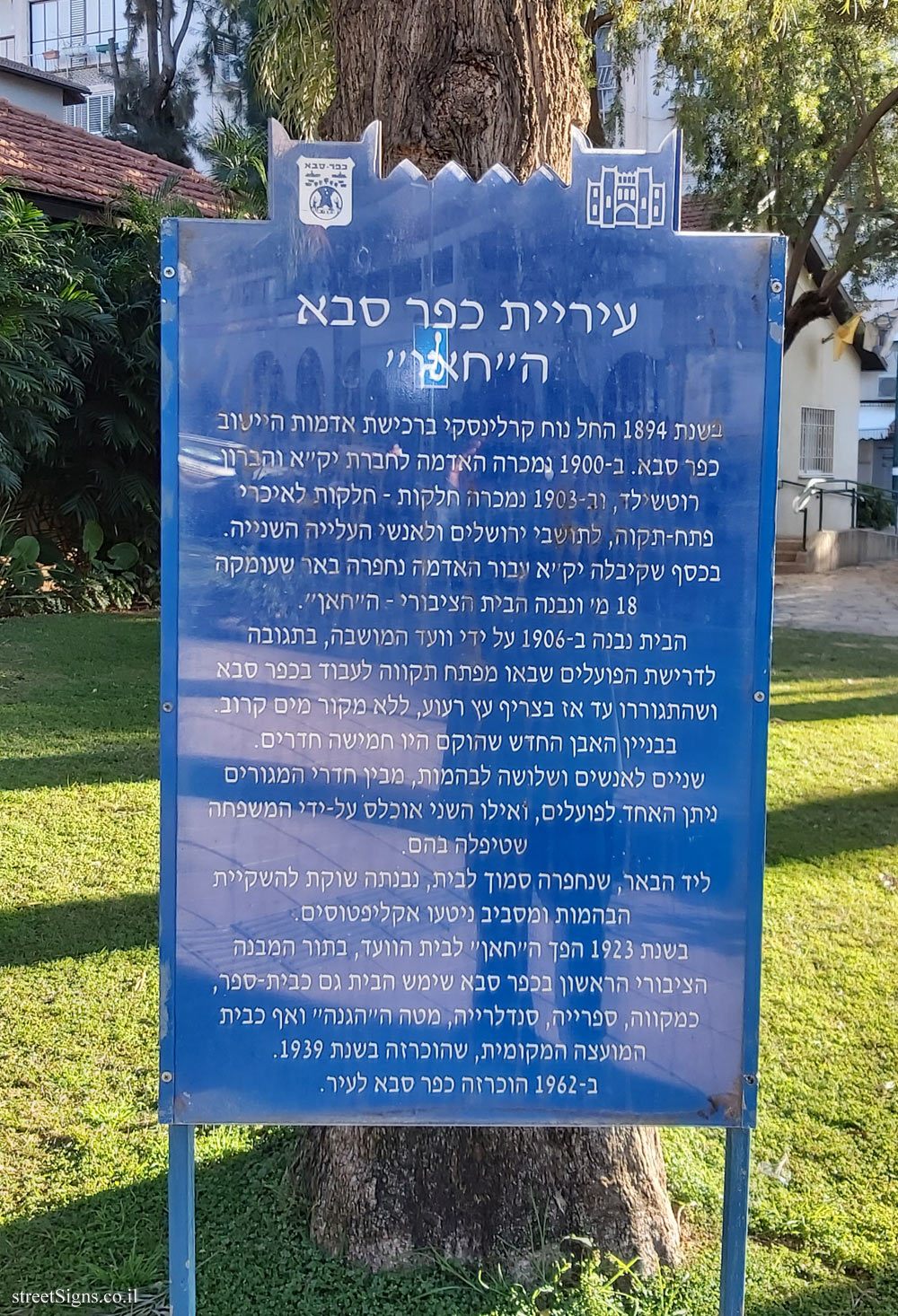On the sign:
[תמונה: הח’אן]
[מפת השביל]
[הצד השני של השלט]
הח’אן בית העירייה
The Khan (Inn) City Hall
כפר סבא איננה העיר היחידה אשר זכתה במבנה שדבק בו הכינוי ’ח’אן’. אולם כפר- סבא מתייחדת בעובדה שאותו מבנה שמר מאז ומתמיד על ייעודו הציבורי, הוא לא נעזב, מגוון תפקידיו התרחב במולן השנים, וגם בימים אלה הוא מהווה עדיין את לבה הפועם של העיר.
בניית ה’ח’אן’ החלה בשנת 1906 בכספי המתיישבים. כל איכר שילם לחברת יק"א 76 פרנקים צרפתיים עבור הוצאות ציבוריות, ובכסף שנאסף נחפרה באר שעומקה 17 מ’ ונבנה מבנה ציבורי, כשלושים מ’ אורכו ועשרה מ’ רוחבו.
בתחילה התגוררו בשני חדרים איכרים, פועלים ואורחים מזדמנים שנזקקו לתבשיל חם, ושלושה חדרים שימשו אורוות. במשך השנים פעלו במבנה דואר, מקווה, בית ספר, בית כנסת, משרד של ועד המושבה, בית חולים ארעי עבור פצועי כפר-סבא והיישובים הסמוכים ותחנת נוטרים.
וכך כותב אחד הראשונים: "כיצד לא חשבו על פנים הבית כראוי באופן שיוכלו אנשים לשבת בו. ריצפה לא עשו, את הקירות לא טייחו ואצטבאות למשכב לא הכינו. והחול מעלה שם אבק גדול, המחניק את הנשימה ומגדל כל מיני שרצים ופרעושים הגוזלים מהפועל את המנוחה לאחר יום עבודה קשה".
בימי מלחמת העולם הראשונה, כשנעקרו מביתם יהודי תל-אביב ויפו, השכינו בחדרי ה’אורווה הציבורית’ אחדים מהמגורשים. לאחר ששניים מהדיירים הזמניים חלו בקדחת ונפטרו, הכירו פרנסי המושבה במגרעותיה של האכסניה הזמנית, אבל לא היו מוכנים לוותר על השימוש בח’אן לאירוח דיירים מזדמנים. משום כך הסתפקו בהעברת המגורשים לחדר אחר שנקרא ’בית התבשיל’, משום שיחד עם המגורשים דחסו בו תנורי בישול, מחבתות וסירים. ככל שהצבא הבריטי התקדם צפונה עלה מספר המגורשים שחיפשו מחסה בכפר-סבא. ד"ר הלל יפה נקרא לפתור את הבעיה והוחלט להקים בח’אן בית חולים. בח’אן ביקרו במשך השנים נכבדים שונים, ובהם השופט העליון היהודי מארצות-הברית לואי ברנדיס, שנתקבל כאן בכבוד מלכים בשנת 1919, בסיומה של מלחמת העולם הראשונה.
בסוף שנות ה-20, עם התבססות מושבה לאחר מאורעות תרפ"א, שופץ הח’אן פעם נוספת.
כיום שוכנים במבנה משרדי העירייה העיקריים: לשכת ראש העיר, לשכת מנכ"ל העירייה וחדר הישיבות. הח’אן מופיע בסמלה של העיר, ועדיין ניתן לחזות סמוך לו בבאר הראשונה ובשני עצי האקליפטוס שניטעו לצד האקליפטוסים של שיינפיין.
Kfar Saba is not the only city with a building nicknamed khan. In truth, the bullding was not meant to house passers-by; it was a multipurpose bullding in the middle of the settlement. Kfar Saba is unique in that this building has preserved its original goals as a public oriented building. It was never abandoned, its variety of functions expanded over the years, and even today it is the beating heart of the city. Construction of the khan began in 1906, financed by money paid by the settlers. Every farmer paid to I.C.A 76 French francs for public expenses, and with the money that was collected a 17-meter deep well was dug and a public building was built, about 30 meters long and 20 meters wide.
At the beginning farmers, laborers and passing guests who needed something hot to eat lived in two rooms. Three rooms were used as stables. Over the years the building has been used as a post office, ritual bath, school, synagogue, office of the settlement committee, temporary hospital for the wounded from Kfar Saba and the surrounding settlements and as a watchman’s station.
(In the memoirs of the Sosnovsky family, who lived in the khan during their first years in the settlement, the experience of life there is recalled: the family lived in one room; their neighbors in the next room, the stable, were two horses that which purchased with the small amount of money they had earned from ploughing. The room was divided into two by a screen, so that half would be their living quarters and half would be used to make dairy products, a profession that the father of the family learned in the Ukraine, Russia. The family also writes about the aroma of the challot baked in the courtyard on Fridays and about the kerosene lamp used daily and how it was changed for Friday and Shabbat to oil lamps and candles.
During the First World War, when Jews were uprooted from their Tel Aviv-Jaffa homes, several of the evacuees were housed in the "public stable". When two of the temporary residents became ill with malaria and died, the leaders of the settlement realized the drawbacks of temporary housing, but they weren’t willing to give up using the khan to accept passing through guests. They therefore moved the evacuees into one room which was called "the cooking room", because together with the evacuees, there was a cooking oven and pots and pans in the room. Dr. Hillel Yaffe was called in to solve the problem and it was decided to use the khan as a hospital.
At the end of 1920, as the settlement stabilized after the events of 1921, the khan was once again renovated. Today the major offices of the municipality are located in the building. The Inn appears on the municipal emblem and one can still see the first well and the two eucalyptus trees that were planted next to the building - Sheinfein’s eucalyptus trees.
סמל העיר כפר סבא
סמל מוזיאון כפר סבא
שביל הראשונים על שם מרדכי שרייבמן
המוזיאון הארכיאולוגי כפר-סבא
ירושלים 35 כפר-סבא
טלפון 09.7640867
THE ARCHAEOLOGICAL MUSEUM OF KFAR-SABA
www.kfar-saba-museum.org

 Click for a larger image
Click for a larger image  Click for a larger image
Click for a larger image  Click for a larger image
Click for a larger image  Click for sign's details
Click for sign's details  Click for sign's details
Click for sign's details